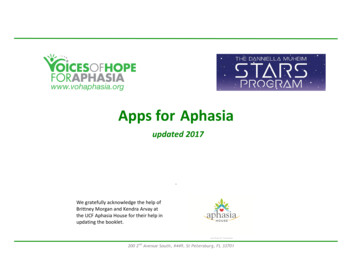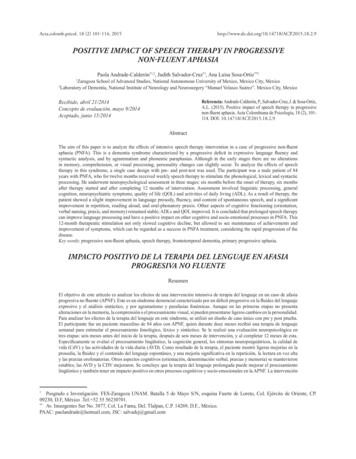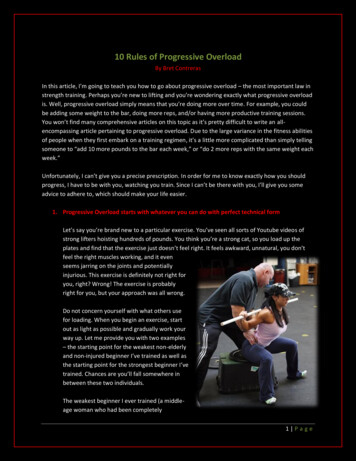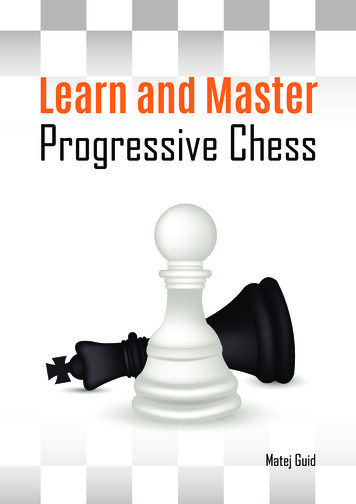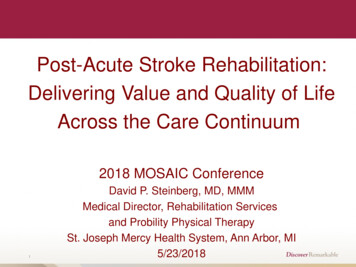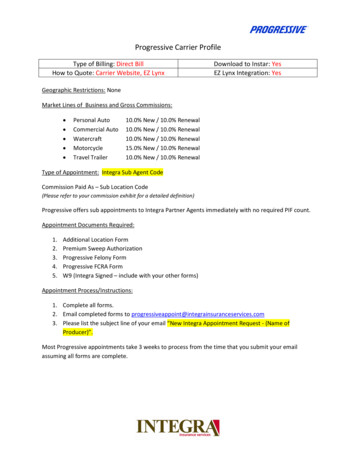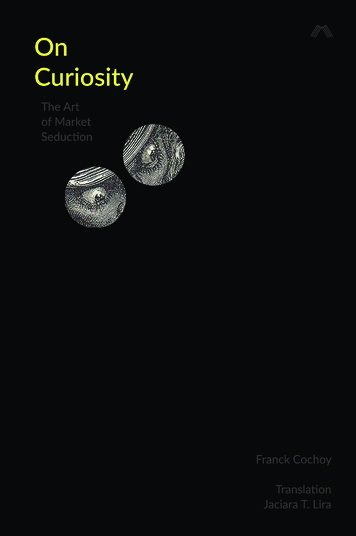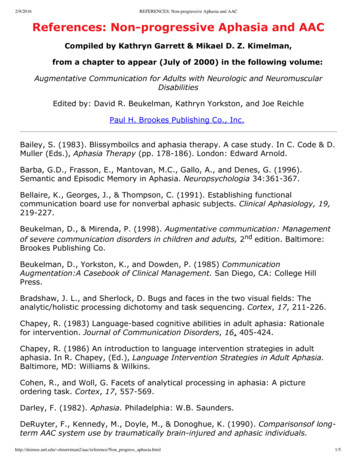
Transcription
2/9/2016REFERENCES: Non-progressive Aphasia and AACReferences: Non progressive Aphasia and AACCompiled by Kathryn Garrett & Mikael D. Z. Kimelman,from a chapter to appear (July of 2000) in the following volume:Augmentative Communication for Adults with Neurologic and NeuromuscularDisabilitiesEdited by: David R. Beukelman, Kathryn Yorkston, and Joe ReichlePaul H. Brookes Publishing Co., Inc.Bailey, S. (1983). Blissymboilcs and aphasia therapy. A case study. In C. Code & D.Muller (Eds.), Aphasia Therapy (pp. 178 186). London: Edward Arnold.Barba, G.D., Frasson, E., Mantovan, M.C., Gallo, A., and Denes, G. (1996).Semantic and Episodic Memory in Aphasia. Neuropsychologia 34:361 367.Bellaire, K., Georges, J., & Thompson, C. (1991). Establishing functionalcommunication board use for nonverbal aphasic subjects. Clinical Aphasiology, 19,219 227.Beukelman, D., & Mirenda, P. (1998). Augmentative communication: Managementof severe communication disorders in children and adults, 2nd edition. Baltimore:Brookes Publishing Co.Beukelman, D., Yorkston, K., and Dowden, P. (1985) CommunicationAugmentation:A Casebook of Clinical Management. San Diego, CA: College HillPress.Bradshaw, J. L., and Sherlock, D. Bugs and faces in the two visual fields: Theanalytic/holistic processing dichotomy and task sequencing. Cortex, 17, 211 226.Chapey, R. (1983) Language based cognitive abilities in adult aphasia: Rationalefor intervention. Journal of Communication Disorders, 16, 405 424.Chapey, R. (1986) An introduction to language intervention strategies in adultaphasia. In R. Chapey, (Ed.), Language Intervention Strategies in Adult Aphasia.Baltimore, MD: Williams & Wilkins.Cohen, R., and Woll, G. Facets of analytical processing in aphasia: A pictureordering task. Cortex, 17, 557 569.Darley, F. (1982). Aphasia. Philadelphia: W.B. Saunders.DeRuyter, F., Kennedy, M., Doyle, M., & Donoghue, K. (1990). Comparisonsof long term AAC system use by traumatically brain injured and aphasic individuals.http://deimos.unl.edu/ dmerriman2/aac/reference/Non progress aphasia.html1/5
2/9/2016REFERENCES: Non-progressive Aphasia and AACUnpublished raw data, Rancho Los Amigos Hospital, Los Angeles, CA.Fitch West, J. (1983) Aphasia: Cognitive considerations. Topics inLanguageDisorders, 3, 49 66.Fried Oken, M. (1995) Story telling as an augmentative communication approachfor a man with severe apraxia of speech and expressive aphasia. ASHA SpecialInterest Division 12 Newsletter: Augmentative and Alternative Communication, 4,3 4.Friedman, A. and Polson, M.C. (1981). The hemispheres as independent processingsystems: limited capacity processing and cerebral specialization. J. ExperimentalPsychology: Human Perceptual Performance, 7, 1031 1058.Garrett, K. (1993) Changes in the conversational participation of individuals withsevere aphasia given three types of partner support. Unpublished doctoraldissertation, University of Nebraska, Lincoln.Garrett, K. (1995) Expanding expressive communication options for a person withsevere aphasia. ASHA Special Interest Division 12 Newsletter: Augmentative andAlternative Communication, 4, 5 7.Garrett, K. (1996) AAC Interventions and Aphasia: Cognitive LinguisticConsiderations. Miniseminar presented at the ISAAC Biennial Convention,Vancouver, B.C.Garrett, K., & Beukelman, D. (1995) Changes in the interaction patterns of anindividual with severe aphasia given three types of partner support. In M. Lemme,(Ed.), Clinical Aphasiology, 23. Austin, TX: Pro Ed.Garrett, K., & Beukelman, D. (1998) Adults with severe aphasia. In D. Beukelman& P. Mirenda (Eds.) Augmentative communication: Management of severecommunication disorders in children and adults (2nd edition). Baltimore: BrookesPublishing Co.Garrett, K., and Beukelman, D. (1992) Augmentative communication approachesfor persons with severe aphasia. In K. Yorkston, (Ed.), Augmentativecommunication in the medical setting (pp. 245 337) Tucson, AZ: CommunicationSkill Builders.Garrett, K., Beukelman, D., and Low Morrow, D. (1989) A comprehensiveaugmentative communication system for an adult with Broca's aphasia.Augmentative and Alternative Communication, 5, 55 61.Glass, A., Gazzaniga, M., & Premack, D. (1975) Artificial language training in globalaphasics. Neuropsychologia, 11, 95 103.Goodglass, H. (1993) Understanding Aphasia. San Diego: Academic Press, Inc. pp.1 7.http://deimos.unl.edu/ dmerriman2/aac/reference/Non progress aphasia.html2/5
2/9/2016REFERENCES: Non-progressive Aphasia and AACGoodglass, H., & Kaplan, E. (1983) The Assessment of AphasiaandRelatedDisorders (2nd edition). Philadelphia: Lea & Febiger.Haarmann, H.J., Just, M.A., and Carpenter, P.A. (1997) Aphasic SentenceComprehension as a Resource Deficit: A Computational Approach. Brain andLanguage 59:76 120.Horner, J., Loverso, F., and Gonzalez Rothi, L. (1994) Models of aphasia treatment.In R. Chapey (Ed.), Language intervention strategies in adult aphasia. Baltimore:Williams & Wilkins.Hux, K., Beukelman, D., and Garrett, K. (1994) In R. Chapey (Ed.), Languageintervention strategies in adult aphasia. Baltimore: Williams & Wilkins.Jackson, H. (1878) On affections of speech from disease of the brain. Brain,1, 304 330.Johannsen Horbach, H., Cegla, B., Mager, V., & Schempp, B. (1985) Treatment ofglobal aphasia with a nonverbal communication system. Brain and Language, 24,74 82.Just, M.A. and Carpenter, P.A. (1992) A capacity theory of comprehension:individual differences in working memory. Psychological Review, 99, 122 149.Kagan, A. (1998) Supported conversation for adults with aphasia: methods andresources for training conversation partners. Aphasiology, 12, 816 830.Kahneman, D. (1973). Attention and Effort. Englewood Cliffs, NJ: Prentice Hall.Kahneman, D. and Triesman, A. (1984) Changing views of attention andautomaticity. In R. Parasuraman and D.R. Davies (Eds.), Varieties of Attention.Orlando, Fl: Academic Press.Kertesz, A. (1982) Western Aphasia Battery. New York: Grune & Stratton.Kimelman, M.D.Z. (1999) Memory load, prosody, and auditory comprehension inaphasia. Paper presented at the Annual Clinical Aphasiology Conference, Key West,Florida.King, J., and Beukelman, D. (1996) Personal communication. Kolk, H. andHartsuiker, R.J. (1999) Aphasia, Prefrontal Dysfunction, and theUse of Word Order Strategies. Behavioral and Brain Sciences 22:103 104.Kraat, A. (1990) Augmentative and alternative communication: does it have afuture in aphasia rehabilitation? Aphasiology, 4, 321 338.Light, J. (1988) Interaction involving individuals using augmentative and alternativecommunication systems: State of the art and future directions. Augmentative andalternative communication, 4, 66 82.http://deimos.unl.edu/ dmerriman2/aac/reference/Non progress aphasia.html3/5
2/9/2016REFERENCES: Non-progressive Aphasia and AACLight, J., and Lindsay, P. (1991) Cognitive science and augmentative andalternative communication. Augmentative and alternative communication, 7, 186 203.Lyon, J. (1992) Communication use and participation in life for adults with aphasiain natural settings: The scope of the problem. American Journal of Speech Language Pathology, 1, 7 14.Loverso, F.L. and Prescott, T. E. (1981) The effect of alerting signals on left braindamaged (aphasic) and normal subjectsí accuracy and response time to visualsimuli. In Brookshire, R.H. (Ed.), Clinical Aphasiology Conference Proceedings.Minneapolis: BRK Publishers.McNeil, M. (1983) Aphasia: neurologic considerations. Topics in languagedisorders,3, 1 19.McNeil, M.R. & Kimelman, M.D.Z. (1986). Toward an integrative information processing structure of auditory comprehension and processing in adult aphasia,Seminars in Speech and Language, 7, 123 146.McNeil, M.R., Odell, K, & Tseng, C.H. (1990). Toward the integration of resourceallocation into a general model of aphasia. In Prescott, T. (Ed.), ClinicalAphasiology. Austin, TX: Pro Ed,Mesulam, M.M. (1981). A cortical network for directed attention and unilateralneglect. Annals of Neurology, 10, 309 325.Navon, D. and Gopher, D. (1979) On the economy of the human processingsystem. Psychological Review, 56, 214 255.Nicholas, M., & Helm Estabrooks, N. (1990) Aphasia. In J. Atwood (Ed.)Seminars in Speech and Language: The Efficacy of Speech Language PathologyIntervention, 11, 135 144.Ostergaard, A.L. and Meudell, P.R. (1984) Immediate Memory Span, RecognitionMemory for Subspan Series of Words, and Serial Position Effects in RecognitionMemory for Supraspan Series of Verbal and Nonverbal Items in Broca's andWernicke's Aphasia. Brain and Language 22:1 13.Peach, R. K., Newhoff, M. & Rubin, S.S. (1993). Attention in aphasia as revealedby event related potentials: A preliminary study. In M.L. Lemme (Ed.) ClinicalAphasiology, 21, Austin Tx: Pro Ed.Porch, B. (1981) Porch Index of Communicative Ability (3rd edition). Palo Alto: CA:Consulting Psychologists Press.Purdy, M., Duffy, R., and Coelho, C. (1994) An investigation of the communicativeuse of trained symbols following multimodality training. Clinical Aphasiology, 22,345 356.http://deimos.unl.edu/ dmerriman2/aac/reference/Non progress aphasia.html4/5
2/9/2016REFERENCES: Non-progressive Aphasia and AACRobey, R. (1994) The efficacy of treatment for aphasic persons: a meta analysis.Brain and Language, 47, 582 608.Schuell, H., Jenkins, J., and Jiminez Pabon, E. (1964) Aphasia in adults.New York:Harper Medical Division.Schuell, H. (1965) The Minnesota Test for Differential Diagnosis ofAphasia.Minneapolis, MN: University of Minnesota Press.Sigafoos, J., and York, J. (1991). Using ecological inventories to promote functionalcommunication. In J. Reichle, J., York, & J. Sigafoos (Eds.), Implementingaugmentative and alternative communication (pp. 61 70). Baltimore: Paul H.Brookes Publishing Co., Inc.Simmons Mackie, N. (1998) In support of supported conversation for adults withaphasia. Aphasiology, 12, 831 838.Simmons Mackie, N.N., and Damico, J.S. (1995) Communicative competence inaphasia: Evidence from compensatory strategies. ClinicalAphasiology, 23, 95 106.Not sure, might have to cite this as a book.Stark, J. (1988) Aspects of automatic versus controlled processing, monitoring,metalinguistic tasks, and related phenomena in aphasia. In W. Dressler and J. Stark(Eds.), Linguistic Analyses of Aphasic Language. New York: Springer Verlag.Stuart, S. (1994) Personal communication.Stuart, S. (1995) Expanding communicative participation using augmentative andalternative communication within a game playing activity for a man with severeaphasia. ASHA Special Interest Division 12 Newsletter: Augmentative andAlternative Communication, 4, 9 11.Thorburn, L, Newhoff, M., and Rubin, S. (1995) Ability of subjects with aphasia tovisually analyze written language, pantomime, and iconographic symbols. AmericanJournal of Speech Language Pathology, 4, 174 179.Weinrich, M., Steele, R., Carlson, G., & Kleczewska, M. (1989) Processing of visualsyntax in a globally aphasic patient. Brain and Language, 36, 391 405.Wepman,J. and Jones, L. (1961) Studies in Aphasia: An Approach toTesting:TheLanguage Modalities Test for Aphasia. Chicago: Education Industry Service.Yanak, K., and Light, J. (1991) Use of augmentative communication with personswith Broca's aphasia: A case Study. National Student Speech Language HearingAssociation Journal,19, 27 34.http://deimos.unl.edu/ dmerriman2/aac/reference/Non progress aphasia.html5/5
dissertation, University of Nebraska, Lincoln. Garrett, K. (1995) Expanding expressive communication options for a person with severe aphasia. ASHA Special Interest Division 12 Newsletter: Augmentative and Alternative Communication, 4, 5 7. Garrett, K. (1996) AAC Interventions and Aphasia: Cognitive Linguistic

